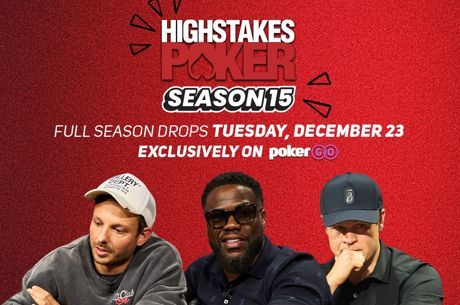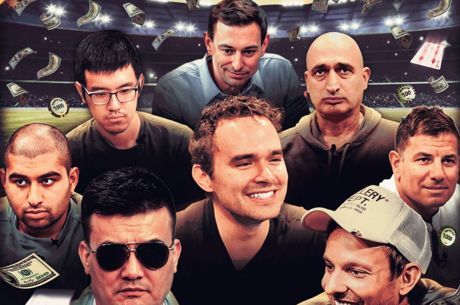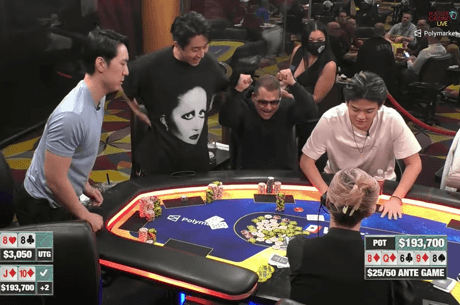Battle of the Poker Game Shows: Full Tilt's Face The Ace vs. the PokerStars Million Dollar Challenge

The introduction of poker-themed game shows is exciting for those of us in the poker industry because it introduces the game to an entirely new audience, and in turn, one hopes, brings a flock of new players to the player pool. Full Tilt's “Face the Ace” and the “PokerStars Million Dollar Challenge” both bring a unique product to the market, but if this was a prize fight, it's pretty safe to say that the “PokerStars Million Dollar Challenge” has won this decision by way of a knock-out.
Time Slot
The 2.1 rating the “PokerStars Million Dollar Challenge” received is the highest Nielson rating any poker programming has ever received, and an estimated 4 million viewers watched the show. In comparison, “Face the Ace” debuted to a 0.3 rating for its first episode, which was enough for the networks to pull it from its initial Saturday night time slot.
Scoring a solid time slot is imperative for the success of a new show, and it is admirable that “Face the Ace” attempted to go prime time with it's first few episodes, but the decision should be viewed as questionable as to why all the episodes were not planned for Saturday afternoons, as surely prime time would be, and was not a good fit. NBC had seen positive Saturday and Sunday afternoon poker ratings in the past with its NBC Heads-Up Championship, so it seems logical to stick with what worked for a poker show that sought to grab the sports-watching demographic. On the other hand, the “PokerStars Million Dollar Challenge” was positioned directly after NFL football on Fox, which has immediately proven fruitful for the show. The show grabs football fans who want continued adrenaline-pumping action after their favorite team is done playing and have found it in poker without even touching their remotes.
A clear win for PokerStars here.
Production
While both programs are solidly produced shows that look and feel like legitimate game shows, the edge here, once again, goes to the “PokerStars Million Dollar Challenge.” The scope of the set, from the use of lights like those on "Who Wants to Be a Millionaire," to the sheer size of the stage, to the sizable enthusiastic audience, and finally to the the added ambience of having the PokerStars Pros and celebs in plain sight on the set, all gave the show an energy that is not quite matched by Full Tilt's “Face the Ace.”
“Face the Ace” has the intrigue of door #1, door #2 and door#3 with top-tier pros like Gus Hansen, Chris Ferguson or Phil Ivey waiting to pop out from behind them. For me, though, this is where the excitement of the staging ends. In more recent episodes, you have the audience rushing the table for all-in situations, but it is obvious that the audience is not large and that it consists mostly of friends and family of the contestants. The set, while crisp and easy on the eyes, is similar to what we've seen before with poker programming, and for this reason it does not entice viewers into what looks like an entirely new poker experience as the "Million Dollar Challenge does.”
Host
It's slightly more difficult to compare the hosts for both “Face the Ace” and the “PokerStars Million Dollar Challenge,” because “Face the Ace” uses two hosts in Ali Nejad and Steve Schirripa, while the “PokerStars Million Dollar Challenge” leaves the hosting to one man, Chris Rose. If “Face the Ace” did away with Schirripa, I think it would be safe to call this one a push because Nejad has a strong understanding of poker and does an excellent job emceeing the action. Schirripa’s lack of both hosting experience and knowledge of the game slows down the show for viewers. Sometimes his commentary during the action or his statements to the players are difficult to follow and somewhat misguided. For example, in one match, he begins asking Gavin Smith and his opponent whether they were interested in a slice of pizza. His intentions for bringing humor to the show may be good, but his delivery is a swing-and-a-miss for both poker enthusiasts and mainstream audiences.
Chris Rose, although not a poker expert, brings lots of experience from his days hosting the “Best Damned Sports Show” and from his work in various poker programming situations on Fox over the years. Instead of attempting to become part of the show as a character himself, he does his job by describing the action and soliciting insights from both the poker players and contestants. It's almost too simple, but by allowing the cast of characters to take center stage and by staying out of the lime light, Rose excels as a host.
Advantage "PokerStars Million Dollar Challenge."
Personalities and Contestants:
Both Full Tilt Poker and PokerStars have amazing stables of some of the best poker players in the world. But while the likes of Phil Ivey, Howard Lederer, Erick Lindgren and Chris Ferguson are all amazing, none is as charismatic and comfortable on camera as PokerStars Pro Daniel Negreanu. The producers have their ace-in-the-hole with Negreanu and went with it, ensuring that he was on stage as much as possible. Whether Negreanu is coaching amateurs by their sides or battling against them himself, his banter makes the show tick. He gives the audience an insight into the mind of a professional poker player like no one else in the world can, and it's evident in the show’s finished product. The inclusion of celebrities like 2008 Playmate of the Year Jayde Nicole and former NFL star Jerome Bettis help, but when push comes to shove, people want to watch Daniel Negreanu.
As for the contestants, PokerStars used its position as second-to-act by watching the somewhat camera shy, unenthusiastic contestants on “Face the Ace” and figured out how to fix the problem. Instead of simply letting contestants merely win a spot on to the show, contestants also have to submit casting videos. This allows the producers to find interesting characters who can add to the show instead of take away from it. This plan works brilliantly, so far, with the show highlighting a poker playing priest and a military man who is not afraid to get into character by spitting lines from "Full Metal Jacket." As an audience, we can easily get on a contestant’s side and have a rooting interest while on “Face the Ace” the contestants are often so quiet or awkward on camera that it becomes difficult for us to relate to them.
Format
Both formats are similar in that you must win three heads-up matches to win the grand prize; however, “Face the Ace” again went with the straightforward approach. No bells. No whistles. Contestants just play straight heads-up poker against one pro and if they win they earn $40,000. Contestants then need to risk it all to play for $200,000 against pro number two, and then in a third match risking it all again for $1 million. The reality of this format is that contestants are always at a disadvantage. Not only do contestants have to square off against three highly trained professionals, but if they win they then have to decide whether to risk everything they've just won by giving in to greed and going for more money.
“PokerStars Million Dollar Challenge,” on the other hand, gives a contestant an edge in match number one by first facing him or her off against a celebrity instead of a poker pro, and solidifies the contestant as a favorite by allowing Negreanu to sit by the contestant’s side, giving the amateur help when needed. If the player wins that match, he or she wins a trip to the Bahamas, which cannot be lost. There are no tricky money decisions before playing match number two, which surely has to put a contestant at ease. In match number two, the contestant, once again, gets help from Negreanu, which gives the player a legitimate shot at the $25,000. If the player wins that match, then as on “Face the Ace,” a difficult decision needs to be made as to whether or not to keep the 25k or go for 100k. This time though, the player sits opposite Negreanu and gets no help. Even if a player goes for 100k and loses, however, he or she still walks away the winner of a great vacation.
I hate to sound like a broken record here, but the check mark once again falls in favor of the "PokerStars Million Dollar Challenge."
All in all, while it looks as though the “PokerStars Million Dollar Challenge” is a clear winner in this battle of poker game shows, we should be extremely excited and thankful that there are two great options bringing poker to the forefront on network television. The games stars like Phil Ivey, Gus Hansen, Patrik Antonius, Vanessa Rousso and Barry Greenstein are getting exposure that is necessary to help give poker legitimacy in the mainstream, which makes the real winners the poker community and poker fans.
Follow us on Twitter for up-to-the-minute news, and also become our fan on Facebook.
*updated 3:15 p.m PST









